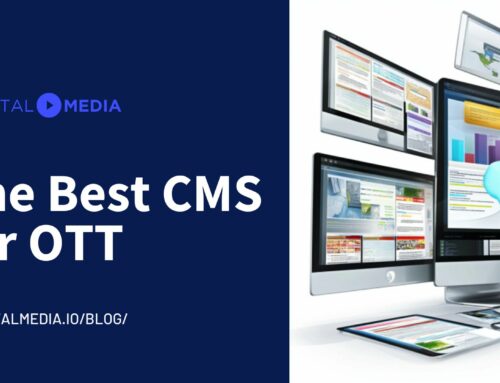The landscape of streaming entertainment is constantly evolving, and the upcoming year will be no exception. Let’s explore the key trends that will influence OTT platforms and the streaming industry during the next year, 2024, and beyond
Integration of AI in Over-The-Top (OTT) Platforms
Artificial Intelligence (AI) is playing an increasingly significant role in the Over-the-Top (OTT) industry. Its influence ranges from content recommendation to production and distribution. What does AI bring to the streaming business?:
- Personalized recommendation: AI in OTT uses advanced algorithms to analyze user behavior, viewing preferences, and browsing history. This information is employed to offer highly personalized recommendations, enhancing the viewer’s experience by suggesting relevant content tailored to their individual tastes. In May 2016, Netflix implemented AI technology to create a superior personalized experience for its subscribed consumers. This AI-powered system automatically accomplished various machine learning processes, offering program and movie recommendations.
- Content creation: AI is also venturing into content creation. Through generative AI techniques like machine learning and neural networks, original content can be generated. Experience shows that generative AI can drastically increase the capacity, speed, and volume of content production, for instance, by simultaneously creating scripts, voiceovers, translations, and images to produce a video or entirely novel virtual worlds for games, at a fraction of the cost and time previously required.
- Ad personalization: By employing AI, OTT platforms can deliver more accurate and personalized ads, maximizing relevance for the viewer and increasing the effectiveness of advertising.
- Content and metadata management: AI facilitates the efficient management of large amounts of content. It can automatically tag, catalog, and organize metadata, streamlining content search and improving accuracy in recommendations.
The integration of AI into the OTT ecosystem not only enhances the user experience but also allows for more effective and efficient content management. This translates to higher viewer retention, increased engagement, and the ability to better anticipate and meet changing consumer demands. Ultimately, AI is transforming the OTT landscape, redefining how audiovisual content is produced, distributed, and consumed in the digital era.
Blockchain technology in OTT ecosystems
Blockchain brings valuable contributions to OTT ecosystems.
- Decentralized content distribution models: With Blockchain, users can verify transactions directly without involving any intermediaries. Furthermore, the need for a central authority to approve transactions between peers is eradicated, making transactions secure and faster.
- Copyright protection and brand safeguarding: Blockchain technology enables the creation of copyright tokens, allowing creators of content in these OTT 3.0 platforms to protect and ensure intellectual property or brand and thus properly control its distribution. Contents can be accessed from anywhere with decryption keys through smart contracts.
- Security and data control: One of the most common benefits in all blockchain systems like Web3 is security, thanks to data encryption that protects end-user information. User privacy is ensured in these systems.
- New audience attraction methods: Blockchain through smart contracts, tokens, or NFTs offers endless possibilities for user loyalty with more optimal and faster ways to reach users and with new gamification techniques to attract new audiences, such as creating fan tokens or launching reward programs.
- New monetization and marketing avenues: Blockchain can facilitate tracking publishers, creators, and copyright holders to generate new ways to monetize their work, integrating NFTs, cryptocurrencies, wallets, or creating marketplaces where NFT movies or iconic brands can launch VR/AR collectibles.
Increased emphasis on advertising
In the coming years, a significant increase in revenues from advertising-based video streaming platforms is projected. What’s interesting is how the streaming industry has transformed its approach: from promoting platforms as free from annoying ads to considering advertising as an essential revenue source.
A notable example is Netflix, a company that, in its first 25 years, completely rejected advertising. However, in 2022, it launched a service tier with ads at a lower price in certain regions while simultaneously increasing the cost of the ad-free version. By May 2023, Netflix announced that its ad-supported service had already attracted nearly 5 million subscribers, marking a strategic shift that other competitors are closely following.
The global OTT video industry is expected to grow at an annual rate of 8.4% to reach $116.5 billion between 2022 and 2027. The subscription video-on-demand (SVOD) model, which has been the main driver of streaming expansion over the past decade, will continue to be the main revenue generator in the OTT domain. This sector will surpass the $100 billion mark in 2025 and will represent 62.5% ($109.1 billion) of the global OTT market in 2027. However, a significant slowdown in SVOD market growth is expected: from an increase of 18.5% in 2022 to a rise of 8.6% in 2024 and only 3.4% in 2027. This slowdown in the SVOD market will drive activity and opportunities in the AVOD (Advertising-based Video on Demand) sector, which is currently underexploited. Total global AVOD revenues are projected to increase at an average annual rate of 13.8%, rising from $28.7 billion in 2022 to $54.8 billion in 2027.
Hyperpersonalization in OTT Platforms
The trend toward hyperpersonalization in OTT platforms represents a fundamental shift in how content is delivered and experienced. It’s a highly user-centric approach aimed at providing viewing experiences tailored to the individual preferences of each viewer.
These platforms are utilizing advanced user data, behavior analysis, and artificial intelligence algorithms to better understand their audience. The idea is to personalize not only the content offered but also the user experience itself. From the interface to content recommendations, everything is adjusted to provide a more relevant and engaging experience.
Hyperpersonalization encompasses various aspects:
- Personalized recommendations: OTT platforms use sophisticated algorithms that analyze viewing history, past interactions, and preferences to offer highly personalized content recommendations. This ensures that viewers discover new movies or series aligned with their interests.
- Adaptable interfaces: User interfaces can be adjusted according to individual preferences. This includes section layouts and customization of colors and themes, offering a more comfortable and attractive experience for each user.
- Dynamic content: Some platforms are experimenting with interactive or branched content that adapts to viewer decisions, offering unique and personalized experiences based on the choices made during viewing.
- Personalized advertising: Platforms can use behavioral data to deliver more relevant and personalized ads, improving advertising effectiveness and reducing interruptions for users.
The ultimate goal is to create a viewing experience that feels unique to each user, thereby increasing engagement, retention, and satisfaction. Hyperpersonalization not only enhances the user experience but also benefits platforms by fostering loyalty and word-of-mouth, leading to greater growth and success in the highly competitive OTT market.
The digital future relies on the ability to offer a user experience as varied and individual as the audience it serves.
Rise of verticalized OTT Platforms
The surge of verticalized OTT content marks a significant evolution in how content is distributed and consumed across streaming platforms. This trend focuses on creating and distributing content that is specific and targeted towards particular audiences or niche markets.
Rather than offering a broad and general range of content, verticalized OTT platforms specialize in specific thematic areas like fitness, cooking, music, education, wellness, among others. These services strive to meet the unique needs and interests of specific audience segments.
The key to success in this model lies in content personalization and specialization. These platforms aim to fill existing market gaps by offering a variety of content that closely aligns with the interests, passions, and needs of their users.
Verticalized content not only attracts specific audiences but also fosters loyalty and engagement. Users who find content that perfectly fits their interests tend to be more engaged and recurrent on these platforms. Moreover, extreme personalization can lead to more immersive and relevant user experiences, enhancing satisfaction and retention.
Supporting this trend, Grand View Research data forecasts that the global video streaming market will grow by 21.5%, reaching $89.03 billion in 2027, up from $89.03 billion in 2022.
OTT strategies beyond FAST Channels
FAST channels have emerged as a significant evolution in the streaming landscape by offering free entertainment. However, the proliferation of FAST channels presents challenges in being discovered and standing out in a crowded market.
While FAST adds value by providing quick access to free content, it does not constitute a singular and comprehensive solution for driving a sustainable business model in OTT streaming. Incorporating linear channels alongside on-demand content within OTT applications allows for a more varied viewing experience adaptable to different consumer preferences. Recognizing the multifaceted nature of viewing habits, these strategies aim to offer a balanced mix of immediacy and depth.
Innovation in user acquisition
Major players like American Express and Verizon are leading the way by offering streaming service benefits as part of their packages. This trend is extending to diverse sectors, as industries like utilities and even healthcare are starting to integrate streaming benefits into their service offerings. This approach offers a smart way to access large user bases, crucial in an environment where traditional marketing can be costly, and the risk of saturating existing audiences is high.
This system serves as an innovative solution to high user acquisition costs. By forging partnerships, streaming services can reach new audiences, often with the added benefit of receiving payments for their content. This model not only expands the user base but also introduces streaming content to a broader and more diverse demographic. It’s a mutually beneficial scenario where partners provide value-added services to their customers, and streaming platforms gain new subscribers without the high marketing costs.
Decreased dominance of the OTT industry in North America
The year 2024 marks a turning point for the streaming industry, anticipating a significant geographical transformation in global revenue distribution. For over a decade, North America has held undisputed leadership since the early days of the streaming era with the birth of Netflix in 2007. However, it is projected that this region will reduce its contribution, accounting for less than half of the global revenues generated by Subscription Video On Demand (SVOD) models in OTT, with Western Europe and Asia-Pacific gaining weight.
This transition not only represents a shift in economic flows but also offers a strategic opportunity for streaming companies to expand and diversify into emerging international markets. Industry giants like Netflix, Amazon Prime, and Disney+ are leading the charge by producing over 50% of their upcoming series outside the United States. The path to streaming revenue success is closely tied to the ability to capitalize on opportunities present in these growing international markets.
In conclusion, significant changes are anticipated in the world of streaming entertainment. With the constant evolution of technology and consumer preferences, the upcoming year 2024 promises to be an exciting and transformative period.
At Fractal Media, we offer you the opportunity to develop your own OTT by integrating all these innovations (AI, Blockchain, FAST channels…). Contact us if you want to explore our solution or need advisory support.





